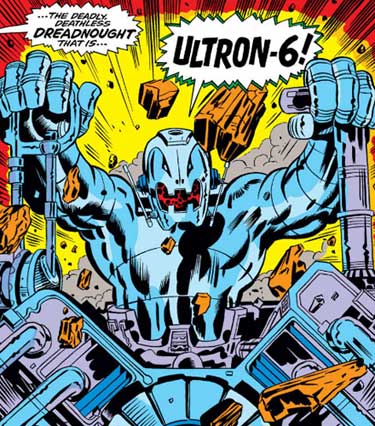
INTRODUCTION
First introduced in Avengers (1st series) #66, Adamantium is the go-to indestructible metal in the Marvel Universe. It is most famously known for Wolverine’s unbreakable skeleton and claws, but has been used for a wide variety of purposes and by many characters over the years. The history of Adamantium extends from the early days of World War II, to the far-flung 31st century. The details of Adamantium, its usage, its derivatives and its history will be covered in this article.
PROTO(TYPE) ADAMANTIUM
The story of Adamantium begins with the development of Captain America’s famous indestructible shield. It was actually many decades before Cap’s shield was connected to Adamantium in the comics. In fact, the shield’s composition was originally nothing special. In Avengers (1st series) #34, Captain America’s shield was disintegrated by the Living Laser’s deathtrap, and Cap didn’t bat an eye. After returning to the mansion, Cap returned to battle with shield in hand, the implication being he just grabbed a spare shield off the rack. Years later (and well after the introduction of Adamantium and Wolverine’s claws),
 Cap still only identified his shield as a “top secret, super-strong alloy” in Avengers (1st series) #184. It wasn’t until Captain America (1st series) #255 that the shield was retconned into being a unique, one-of-a-kind creation, and not until Captain America (1st series) #302-304 that it was tied to Adamantium.
Cap still only identified his shield as a “top secret, super-strong alloy” in Avengers (1st series) #184. It wasn’t until Captain America (1st series) #255 that the shield was retconned into being a unique, one-of-a-kind creation, and not until Captain America (1st series) #302-304 that it was tied to Adamantium.
Myron MacLain was a scientist working for the United States government at the start of World War II. During his efforts to create a new, unbreakable alloy for the war effort, he was provided with a sample of Vibranium after the young Captain America’s successful expedition to Wakanda (as seen in Black Panther (3rd series) #30). Using the Vibranium sample, MacLain attempted to combine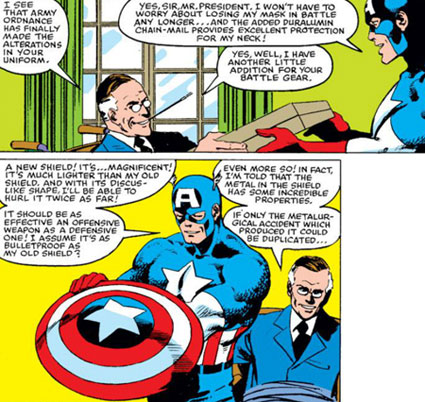 it with a highly-durable steel alloy he had been working on. Unsuccessful and exhausted, MacLain fell asleep at his work bench only to awaken hours later and discover the alloys had combined on their own. An x-factor somehow entered the process while he slept, forging the new metal but leaving MacLain unable to duplicate the process no matter how he tried. MacLain cast the new metal into a disk-shaped mold (based on the hatch lid to a tank), and Captain America’s shield was born.
it with a highly-durable steel alloy he had been working on. Unsuccessful and exhausted, MacLain fell asleep at his work bench only to awaken hours later and discover the alloys had combined on their own. An x-factor somehow entered the process while he slept, forging the new metal but leaving MacLain unable to duplicate the process no matter how he tried. MacLain cast the new metal into a disk-shaped mold (based on the hatch lid to a tank), and Captain America’s shield was born.
Myron MacLain would spend decades attempting to recreate the happy accident that resulted in the shield. His best efforts would only create the inferior, but still nigh-unbreakable, alloy known as Adamantium. (Although it hasn’t been addressed directly, the sliding time scale for the Marvel Universe will probably retcon Adamantium’s creation at some point, changing things so that “Myron MacLain III” created Adamantium in modern times based on his grandfather’s notes on his WWII experiments.) To differentiate the two, Captain America’s shield has occasionally been retroactively referred to as Proto-Adamantium, while MacLain’s later creation is referred to as True Adamantium. Despite the name (and certain erroneous accounts from early OHOTMU volumes), the shield does not contain any True Adamantium, or Adamantium of any other kind, only steel and vibranium, as confirmed in Avengers Annual 2001. The formula that creates Adamantium was not discovered by MacLain until his later efforts to recreate the shield’s unique properties.
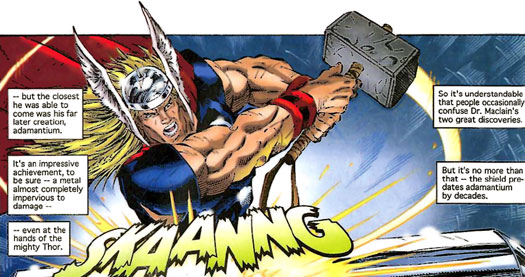
SECONDARY ADAMANTIUM
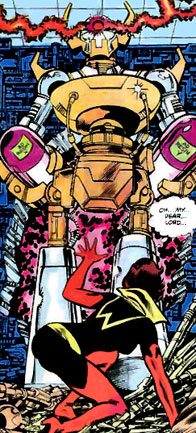
True Adamantium is forged through the bonding of two liquid chemical resins at temperatures greater than 1500 F. These resins were identified as Adamantium Resin X and Y in Avengers (1st series) #201-202, and Adamantium Resin A and B in Avengers (3rd series) #21-22, but otherwise have no official names. Once mixed together, the resins remain fluid and malleable for eight minutes before their molecular structures fully settle and harden into an unbreakable metal form. When Adamantium is fully cooled, it remains set in that shape indefinitely, even when exposed to temperatures over one thousand times higher than the temperature at which it is molded.
True Adamantium is extremely difficult to create, due to both the scarcity of the exotic materials and technical requirements in the forging process itself. Over time, however, many writers in the Marvel Universe began bending the rules when it came to Adamantium’s two most prominent features: that it was both rare and unbreakable. The destruction of Adamantium constructs by the likes of Thor or Hulk was perhaps acceptable, but Wonder Man? Blastaar? Furthermore, Adamantium began to turn up everywhere, from disposable weapons used by glorified cat burglars like the Bombardiers, to Alicia Masters’ studio and sculptures, to an Adamantium chair built for the Hulk by the Defenders. The biggest violator of the rules (literally) was FAUST (Fully-Automated Unit of Structural Technology)…a whole engineering factory and super-computer composed entirely out of Adamantium.
And so, the idea of Secondary Adamantium was created, apparently by the original Official Handbook to the Marvel Universe. Secondary Adamantium is a weaker derivative of the True Adamantium formula. It is still many times more durable than titanium steel, but by no means unbreakable. The benefit of Secondary Adamantium is that it is much cheaper and easier to produce, and mass-produce, than True Adamantium.

The Secondary Adamantium retcon eventually made it out of the Handbooks and into the comics themselves, particularly in Kurt Busiek’s Ultron Unlimited arc from Avengers (3rd series) #19-22, which briefly compared and contrasted the strength of titanium, Secondary and True Adamantium. The existence of Secondary Adamantium helps maintain the rarity and unbreakable nature of True Adamantium, while still explaining the existence of Bishop’s disposable Adamantium hockey puck from X-Treme X-Men (1st series) #4. Of course, being a retcon, it’s often up to the readers to decide whether True Adamantium or Secondary Adamantium was present in a given story. As a result, there are arguments about the Hulk’s strength vs. True or Secondary Adamantium in certain corners of the internet which have been raging nonstop for over a decade.
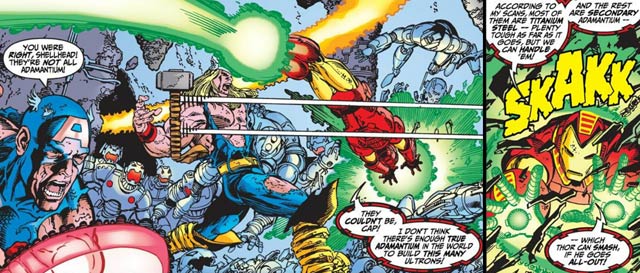
In X-Men (2nd series) #191, Serafina from the Children of the Vault claimed that Adamantium has thirteen allotropic forms, most of which are short-lived and extremely virulent. It’s possible that one of these allotropic forms is the Soviet-designed alloy known as Carbonadium. First referenced in X-Men (2nd series) #5 as “a more malleable form of Adamantium,” Carbonadium was created during the Cold War by the USSR for their Super-Soldier Program. Allegedly an inferior effort to duplicate the formula for True Adamantium, Carbonadium is cheaper to produce and not as strong. (How it compares to Secondary Adamantium is unknown.) Nevertheless, Carbonadium is still tremendously durable and also far more flexible than True Adamantium, allowing for the creation of Omega Red’s elastic and snake-like coils made of pure Carbonadium.
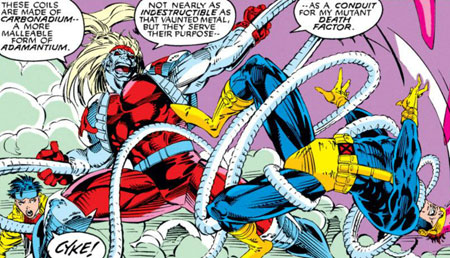 The greatest drawback of Carbonadium, however, is that it is radioactive. Bullets made of Carbonadium substantially slowed Wolverine’s healing factor with their radioactivity. If not for the lifeforce replenishing effect of his death factor, Omega Red would have died of radiation poisoning from his Carbonadium implants years ago. The Carbonadium Synthesizer is a device used to create the alloy, and allegedly would stabilize the Carbonadium in Red’s body. Whether it could neutralize Carbonadium’s radiation in all circumstances or merely in Omega Red’s particular case is unknown.
The greatest drawback of Carbonadium, however, is that it is radioactive. Bullets made of Carbonadium substantially slowed Wolverine’s healing factor with their radioactivity. If not for the lifeforce replenishing effect of his death factor, Omega Red would have died of radiation poisoning from his Carbonadium implants years ago. The Carbonadium Synthesizer is a device used to create the alloy, and allegedly would stabilize the Carbonadium in Red’s body. Whether it could neutralize Carbonadium’s radiation in all circumstances or merely in Omega Red’s particular case is unknown.
VULNERABILITIES
Once True Adamantium is set, only a few things on Earth are confirmed to be able to affect it. The U.S. government employs a specially-focused set of particle beams to cut Adamantium after it sets, which uses up a great deal of power. A molecular rearranger can be used to reshape set Adamantium as well, or even destroy it entirely under a sustained barrage. This method was once used to destroy Doctor Octopus’s Adamantium arms in Lethal Foes of Spider-Man #1.
The Muramasa blade is a weapon introduced in Wolverine (3rd series) #40 able to cut through Adamantium. Muramasa is a possibly immortal Japanese warlord and blacksmith. Through a combination of sorcery and alchemy, he can forge blades out of the pain and darkness of a warrior’s own soul. Although it resembles metal, the Muramasa blade is actually a form of psychoplasmic energy shaped and honed to act like a sword. The blade can not only cut through Adamantium, the wounds it causes cannot be overcome by mutant healing abilities, making it the ultimate weapon in Romulus’s quest to name his successor. It is unclear whether all Muramasa blades have these properties, or if they just relate to the swordsmith’s greatest creation, the blade forged from Wolverine’s own pain and loss.

Another way of destroying Adamantium is through the use of Savage Land Vibranium. While the Wakandan Vibranium absorbs vibration, the Savage Land variety produces vibrations that break down the molecular integrity of metal. This “Anti-Metal” is potent enough to liquefy Adamantium. The first confirmed use of Savage Land Vibranium against Adamantium was in Marc Spector: Moon Knight #51, although it’s likely Spector’s crescent darts were only made from Secondary Adamantium. In Avengers (3rd series) #22, Justice conceived of employing Anti-Metal against Ultron, and Giant-Man successfully pounded his creation into submission, using Anti-Metal cylinders in his bare fists to destroy Ultron’s True Adamantium exo-structure.
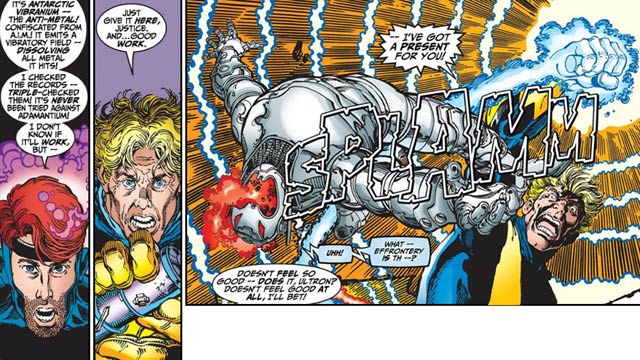
Attacks involving the so-called Wellspring of Power can directly affect Adamantium. The Wellspring of Power is a font of extra-dimensional radiation located in deep space that somehow permeates the fabric of reality. Many superhuman abilities and physics-defying properties of the Marvel Universe are derived through the Wellspring and its effects. Certain metahumans draw power directly from the Wellspring, such as the Squadron Sinister and the Folding Circle. 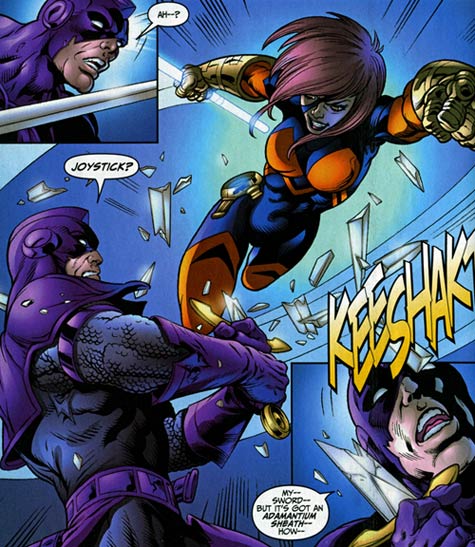 The Wellspring is also responsible for bending the laws of physics throughout the universe to allow exotic substances like Adamantium and Vibranium to manifest their unique properties. An attack that directly struck at the Wellspring’s energies could disrupt those same properties. When the Grandmaster empowered his champion Joystick with the ability to draw from the Wellspring during Thunderbolts (1st series) #102-109, she could not only render the Wellspring-based speedster Speed Demon powerless, but also shattered Swordsman’s Adamantium blade. This is because her energy clubs neutralized the Wellspring’s special properties that made Adamantium unbreakable in the first place.
The Wellspring is also responsible for bending the laws of physics throughout the universe to allow exotic substances like Adamantium and Vibranium to manifest their unique properties. An attack that directly struck at the Wellspring’s energies could disrupt those same properties. When the Grandmaster empowered his champion Joystick with the ability to draw from the Wellspring during Thunderbolts (1st series) #102-109, she could not only render the Wellspring-based speedster Speed Demon powerless, but also shattered Swordsman’s Adamantium blade. This is because her energy clubs neutralized the Wellspring’s special properties that made Adamantium unbreakable in the first place.
Finally, by the year 3014, several substances have been discovered which are stronger than Adamantium. One such substance is Dargonite, and a bullet made from that metal pierced the Adamantium woven suit of Vance Astro in Guardians of the Galaxy (1st series) #18. (Based on its name and the date of its creation, the substance may be related to Dargo K’Tor, the Thor of the 26th century.)
ULTRON
Adamantium was first identified on-panel in Avengers (1st series) #66, where Dr. Myron MacLain unveiled his “new” creation (see below) to the Avengers. As a test of the metal’s mettle, the Avengers’ most powerful members turned their strength against it. Iron Man’s repulsor blasts at peak output didn’t even scratch the material, and a Class 100 strength blow from the Mighty Mjolnir left it scarcely dented.
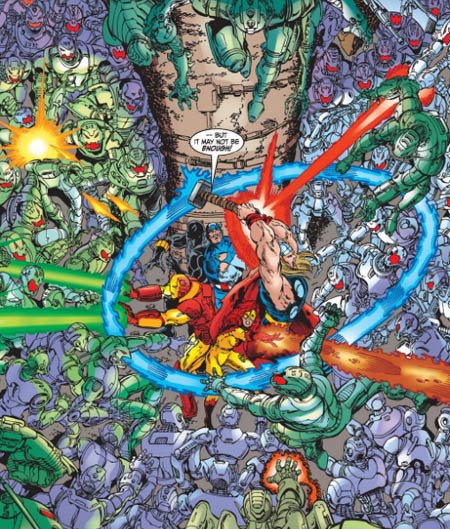 Naturally, it was almost immediately stolen by Ultron. This was Ultron’s first resurrection: his original confrontation with the Avengers was as Ultron-5, and Ultron-6 was the first time he was constructed out of Adamantium. Ultron-7 was a towering giant, and it’s unlikely such a massive frame was composed of True Adamantium, but the subsequent Ultron-8 through Ultron-17 (all appearances between Avengers (1st series) #162 and Avengers: The Ultron Imperative #1) were definitely forged from that unbreakable metal. In Avengers (3rd series) #21-22, Ultron constructed several thousand duplicate bodies for himself, variably composed of titanium steel, Secondary Adamantium and a scarce few of True Adamantium. Although Ultron did not use Adamantium in the construction of his first bride, Jocasta, the second bride Alkhema (aka War Toy) was composed of True Adamantium like her “husband,” and continued using it in her later bodies as well.
Naturally, it was almost immediately stolen by Ultron. This was Ultron’s first resurrection: his original confrontation with the Avengers was as Ultron-5, and Ultron-6 was the first time he was constructed out of Adamantium. Ultron-7 was a towering giant, and it’s unlikely such a massive frame was composed of True Adamantium, but the subsequent Ultron-8 through Ultron-17 (all appearances between Avengers (1st series) #162 and Avengers: The Ultron Imperative #1) were definitely forged from that unbreakable metal. In Avengers (3rd series) #21-22, Ultron constructed several thousand duplicate bodies for himself, variably composed of titanium steel, Secondary Adamantium and a scarce few of True Adamantium. Although Ultron did not use Adamantium in the construction of his first bride, Jocasta, the second bride Alkhema (aka War Toy) was composed of True Adamantium like her “husband,” and continued using it in her later bodies as well.
 Ultron and Alkhema’s mobility is completely dependent on an internal molecular rearranger. Because Adamantium is totally rigid after it settles, a humanoid body composed of the alloy would be impossible to move under normal conditions without leaving exploitable gaps in the armor plating that would accommodate movement systems. Therefore, Ultron uses a molecular rearranger keyed to his internal systems that reshapes the Adamantium of his body moment by moment as he moves. This allows Ultron to employ a solid shell of Adamantium surrounding his entire body that is virtually impossible to penetrate or damage. Each molecular rearranger is specially keyed to the molecular structure of each batch of Adamantium as it forms, making them very rare and unable to affect the molecules or any other structure, Adamantium or otherwise.
Ultron and Alkhema’s mobility is completely dependent on an internal molecular rearranger. Because Adamantium is totally rigid after it settles, a humanoid body composed of the alloy would be impossible to move under normal conditions without leaving exploitable gaps in the armor plating that would accommodate movement systems. Therefore, Ultron uses a molecular rearranger keyed to his internal systems that reshapes the Adamantium of his body moment by moment as he moves. This allows Ultron to employ a solid shell of Adamantium surrounding his entire body that is virtually impossible to penetrate or damage. Each molecular rearranger is specially keyed to the molecular structure of each batch of Adamantium as it forms, making them very rare and unable to affect the molecules or any other structure, Adamantium or otherwise.
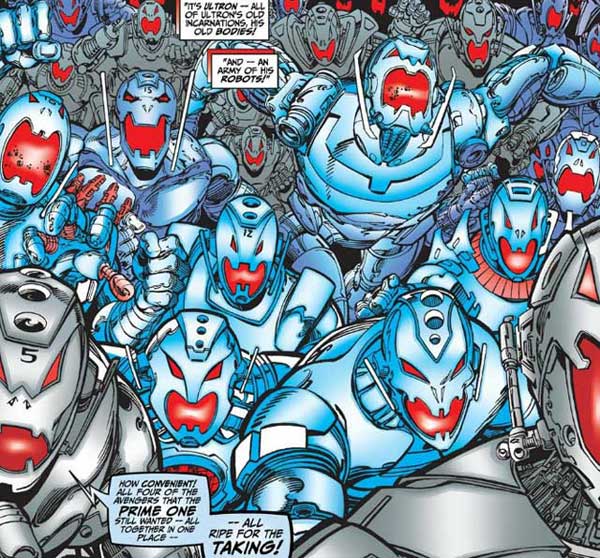
DARKWIND DISCOVERED
The Adamantium bonding process is a method by which the metal can be bonded to a set of bones, giving someone a virtually unbreakable skeleton. The work is attributed to Kenji Oyama, Lord Darkwind of Japan, and was famously used on Wolverine, although not by Darkwind himself.
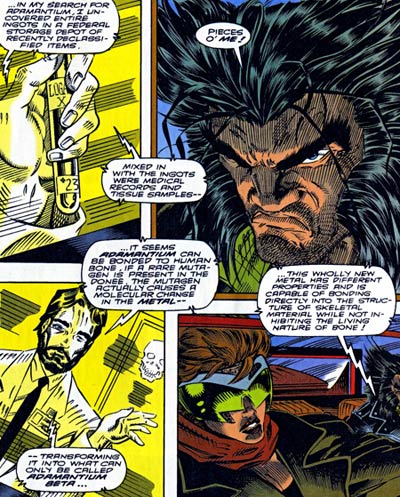 The procedure involves maintaining Adamantium in its liquid state, and then using surgical shunts to flood the still super-heated liquid metal into a subject’s body. As the Adamantium is surgically guided over the subject’s bones, it cools and hardens until it bonds with the skeletal structure at the molecular level. When the Adamantium fully sets, it is as if the subject’s bones were replaced with the super-metal, giving them a permanent, unbreakable Adamantium skeleton. This version of the metal was referred to as Adamantium Beta in Wolverine (2nd series) #80, because it has somehow altered during the process to not impede the normal permeability of bone, while still being unbreakable. Reports that Adamantium Beta is therefore less resistant than True Adamantium, however, are unfounded.
The procedure involves maintaining Adamantium in its liquid state, and then using surgical shunts to flood the still super-heated liquid metal into a subject’s body. As the Adamantium is surgically guided over the subject’s bones, it cools and hardens until it bonds with the skeletal structure at the molecular level. When the Adamantium fully sets, it is as if the subject’s bones were replaced with the super-metal, giving them a permanent, unbreakable Adamantium skeleton. This version of the metal was referred to as Adamantium Beta in Wolverine (2nd series) #80, because it has somehow altered during the process to not impede the normal permeability of bone, while still being unbreakable. Reports that Adamantium Beta is therefore less resistant than True Adamantium, however, are unfounded.
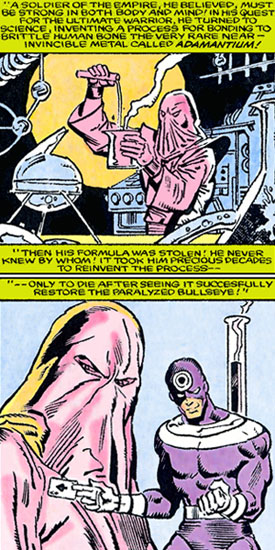 The timeline for Lord Darkwind’s theories requires a little examination. As previously mentioned, Adamantium was supposedly unveiled for the first time in Avengers (1st series) #66. Years later, Wolverine debuted with his Adamantium bones and claws in Incredible Hulk (2nd series) #181. Logan’s origin in the Weapon X Program, however, is confirmed by several sources to take place prior to Fantastic Four (1st series) #1, and the start of the modern Marvel Universe (and, therefore, the Avengers). Furthermore, the Soviets were working to create Carbonadium, a derivative of Adamantium, as far back as 1963. As an explanation, MacLain must have worked on the Adamantium formula for many, many years before giving it its public debut in Avengers (1st series) #66. The United States military and government would have performed countless tests, revisions and evaluations on the “miracle alloy” before showing it off to civilians, even civilian specialists like the Avengers. Lord Darkwind must have become aware of Adamantium and its unique properties at some point during its development in order to form his own theories on its use.
The timeline for Lord Darkwind’s theories requires a little examination. As previously mentioned, Adamantium was supposedly unveiled for the first time in Avengers (1st series) #66. Years later, Wolverine debuted with his Adamantium bones and claws in Incredible Hulk (2nd series) #181. Logan’s origin in the Weapon X Program, however, is confirmed by several sources to take place prior to Fantastic Four (1st series) #1, and the start of the modern Marvel Universe (and, therefore, the Avengers). Furthermore, the Soviets were working to create Carbonadium, a derivative of Adamantium, as far back as 1963. As an explanation, MacLain must have worked on the Adamantium formula for many, many years before giving it its public debut in Avengers (1st series) #66. The United States military and government would have performed countless tests, revisions and evaluations on the “miracle alloy” before showing it off to civilians, even civilian specialists like the Avengers. Lord Darkwind must have become aware of Adamantium and its unique properties at some point during its development in order to form his own theories on its use.
Another irregularity comes from the comparison of the Adamantium bonding process applied to Wolverine, and Lord Darkwind’s own work applying Adamantium to the skeleton of the assassin known as Bullseye. The Weapon X Project considered Logan the perfect subject for the Adamantium bonding process. In fact, many accounts suggest Logan was ONLY able to survive the procedure in the first place because of his healing factor. Analysis of Adamantium Beta in Wolverine (2nd series) #80 indicated the procedure only worked due to an existing mutagen in the test subject, i.e. Logan’s healing factor. And yet Bullseye, an otherwise normal human being, supposedly went through the same process. Bullseye also does not suffer from the “Adamantium poisoning” condition that seems to afflict Wolverine every time he loses his powers.
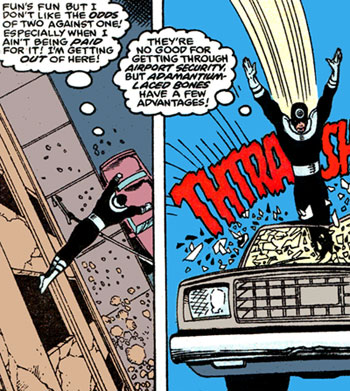 One possibility is that Darkwind understood his own work better than the thieves who stole his notes, and compensated for these problems. What seems more likely based on available evidence, however, is that Bullseye underwent a different process than Wolverine. In the years since his operation, Bullseye has still occasionally suffered from broken bones, indicating that his entire skeleton was not bonded with Adamantium. The process Wolverine underwent fused bones the Weapon X scientists didn't even know he had with Adamantium, so Bullseye could not have had the exact same procedure. Several references have been made to Bullseye receiving “strips” of Adamantium attached to his skeleton. This indicates the assassin underwent a more conventional form of medical procedure (akin to having a metal plate in your head) as opposed to the molecular bonding of metal to his bones that Wolverine did. To tie it all together, one can assume Lord Darkwind envisioned several kinds of Adamantium-based surgical procedures. Bullseye was subjected to a less-invasive form of surgery that merely affixed the metal to the outer surface of his bones, bracing and reinforcing them internally. Darkwind also theorized of a second procedure that would actually bond metal to bone, but never applied his theories because he couldn’t conceive of a man strong enough to survive the process.
One possibility is that Darkwind understood his own work better than the thieves who stole his notes, and compensated for these problems. What seems more likely based on available evidence, however, is that Bullseye underwent a different process than Wolverine. In the years since his operation, Bullseye has still occasionally suffered from broken bones, indicating that his entire skeleton was not bonded with Adamantium. The process Wolverine underwent fused bones the Weapon X scientists didn't even know he had with Adamantium, so Bullseye could not have had the exact same procedure. Several references have been made to Bullseye receiving “strips” of Adamantium attached to his skeleton. This indicates the assassin underwent a more conventional form of medical procedure (akin to having a metal plate in your head) as opposed to the molecular bonding of metal to his bones that Wolverine did. To tie it all together, one can assume Lord Darkwind envisioned several kinds of Adamantium-based surgical procedures. Bullseye was subjected to a less-invasive form of surgery that merely affixed the metal to the outer surface of his bones, bracing and reinforcing them internally. Darkwind also theorized of a second procedure that would actually bond metal to bone, but never applied his theories because he couldn’t conceive of a man strong enough to survive the process.
DARKWIND DERIVED
Several other examples of the Adamantium bonding process have appeared over the years. Romulus orchestrated the transformation of Silas Burr into Cyber as a prototype experiment for the bonding process before it was used on Logan.
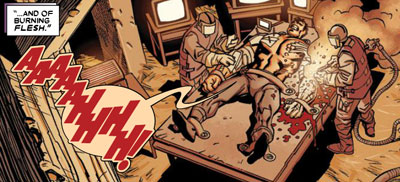 Burr did not have Logan’s extreme regenerative powers, so instead of his bones the Adamantium was bonded to his skin, creating an impenetrable outer casing around his body, as shown in Wolverine: Origins #32. After Cyber died and returned to life by possessing a new body, he repeated the bonding process on his new host, employing the criminal scientist the Tinkerer to facilitate the procedure in Wolverine: Origins #12-13. A similar experiment was performed on Weapon Y, codenamed Citadel, who first appeared in Wolverine: First Class #5. Like Bullseye, however, Citadel was apparently not molecularly bonded to his Adamantium skin. Instead, his skin was surgically fused to an outer armor of Adamantium.
Burr did not have Logan’s extreme regenerative powers, so instead of his bones the Adamantium was bonded to his skin, creating an impenetrable outer casing around his body, as shown in Wolverine: Origins #32. After Cyber died and returned to life by possessing a new body, he repeated the bonding process on his new host, employing the criminal scientist the Tinkerer to facilitate the procedure in Wolverine: Origins #12-13. A similar experiment was performed on Weapon Y, codenamed Citadel, who first appeared in Wolverine: First Class #5. Like Bullseye, however, Citadel was apparently not molecularly bonded to his Adamantium skin. Instead, his skin was surgically fused to an outer armor of Adamantium.
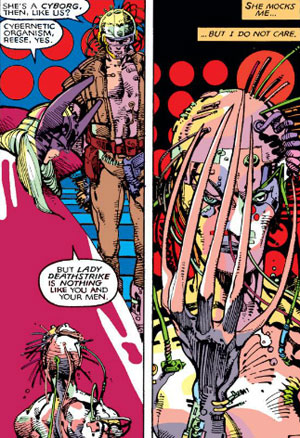 Lady Deathstrike apparently recreated a version of her father’s procedure during her own cybernetic enhancements in Uncanny X-Men (1st series) #205. Because these enhancements were overseen by Spiral in her Body Shoppe, however, the normal rules of the bonding process may not apply. Yuriko is, in essence, a “magic cyborg.” This is likely the explanation for Deathstrike’s otherwise unique applications: in addition to Adamantium-bonded bones, she also demonstrates retractable Adamantium fingernails that can somehow extend several feet in length despite the typical unalterable qualities of the metal.
Lady Deathstrike apparently recreated a version of her father’s procedure during her own cybernetic enhancements in Uncanny X-Men (1st series) #205. Because these enhancements were overseen by Spiral in her Body Shoppe, however, the normal rules of the bonding process may not apply. Yuriko is, in essence, a “magic cyborg.” This is likely the explanation for Deathstrike’s otherwise unique applications: in addition to Adamantium-bonded bones, she also demonstrates retractable Adamantium fingernails that can somehow extend several feet in length despite the typical unalterable qualities of the metal.
Sabretooth has enhanced himself with Adamantium on several occasions. He first received an Adamantium skeleton and claws in Wolverine (2nd series) #126. The Adamantium was later forcibly extracted from his system to create Logan’s new skeleton by Apocalypse in Wolverine (2nd series) #145. Unlike Logan, Creed experienced a condition of “Adamantium withdrawal” after losing his metal and, in Gambit (3rd series) #8-11, the Adamantium from Constrictor’s coils was extracted and used to stabilize Creed’s system. A full Adamantium skeleton was not restored to Sabretooth until Wolverine (2nd series) #161. Romulus also underwent the Adamantium bonding process in Wolverine (2nd series) #310.
The Facility apparently recovered notes on the Adamantium bonding process through their spies inside the Weapon X Project. In X-23 (1st series) #2, they selectively used the procedure on Wolverine’s female clone, X-23. Instead of a full skeleton, only X-23’s six claws were bonded to the unbreakable metal.

The Weapon X Program’s notes were also bought on the black market by RoXXon Oil’s Blackguard group to create a team of Adamantium Men mercenaries in Wolverine: Weapon X #1. Blackguard used nano-tech based implants to create a healing factor for their soldiers so they could survive the bonding process. The Blackguard soldiers also possessed retractable Adamantium claws based on Wolverine’s, further charged by laser energy implants.
Finally, the Tinkerer applied the basic principles of Darkwind’s bonding process to fuse Daken’s third claws with the “metal” of the Muramasa blade in Wolverine: Origins #34. Although not real composed of metal, but rather a form of psychoplasmic energy, the Muramasa blade still responded like metal enough for Tinkerer to melt it down and then bond it to Daken. These claws were eventually forcibly extracted from Daken’s body and hidden away by Wolverine in Wolverine: Origins #48.
PRODUCTION
Today, production of Adamantium is largely under the control of the United States government. Despite many security breaches, the formula is still officially a state secret. The United States apparently licenses different private contractors to distribute Adamantium for them to select clients or projects. Stark International and Hank Pym's private laboratory both had storages of the two main Adamantium resins in Avengers (1st series) #201-202. Adametco was the country's leading manufacturer of Adamantium at one time.
 Despite the precautions, many outside agencies have access to Adamantium. AIM possessed the Adamantium resin batches in Avengers (3rd series) #13, indicating they are equipped to forge True Adamantium. Ultron seems capable of creating his own Adamantium bodies these days. The various renegade government programs connected to Weapon X also have the formula, and through them both RoXXon and the Facility gained access as well. Security leaks apparently provided both the Japanese and Soviet governments with information on the Adamantium formula decades ago.
Despite the precautions, many outside agencies have access to Adamantium. AIM possessed the Adamantium resin batches in Avengers (3rd series) #13, indicating they are equipped to forge True Adamantium. Ultron seems capable of creating his own Adamantium bodies these days. The various renegade government programs connected to Weapon X also have the formula, and through them both RoXXon and the Facility gained access as well. Security leaks apparently provided both the Japanese and Soviet governments with information on the Adamantium formula decades ago.
Apocalypse also had access to Adamantium and the bonding process. Indeed, Chris Claremont originally intended Apocalypse to be responsible for Wolverine's skeleton. The primal rage Wolverine experienced in the presence of Apocalypse's handiwork in Uncanny X-Men (1st series) #242 and Wolverine: The Jungle Adventure was meant to be a reference to that. The latter story also had an inexplicable ancient skull forged of Adamantium found in one of Apocalypse's labs. Barry Windsor Smith deliberately created a power behind the Professor in his original Weapon X story so that Claremont could one day tell that origin. At this point, though, it's more likely the voice the Professor was conversing with during the bonding procedure was that of Romulus.
MASS PRODUCTION
Adamantium has turned up in a wide variety of places over the years, although the distinction between True Adamantium and Secondary Adamantium is not always made. Several containment facilities such as the Raft and the Vault employ Adamantium restraints or Adamantium cells. Reed Richards is known to use laboratories reinforced with Adamantium to prevent his experiments from getting out of control. Various free agencies and operators have also gotten hold of Adamantium bullets or other paraphernalia as well. In addition to the Adamantium users described previously in this article, here is a breakdown of other users over the years.
Characters who use Adamantium
 Agent Zero
Agent Zero
First appearance: X-Men (2nd series) #5
First used Adamantium: Weapon X: The Draft - Agent Zero #1
Among the various weapons provided to him by the Weapon X Program, Zero used a knife and bullets dipped in indestructible Adamantium.
 Battlestar
Battlestar
First appearance: Captain America (1st series) # 323
First used Adamantium: Captain America (1st series) #338
Rogers' replacement, John Walker, had a partner named Battlestar who also employs a shield made of Adamantium.
 Bombardiers
Bombardiers
First appearance: Thor (1st series) #309
Demolition experts for hire, the Bombardiers used a flying rocket car and snare cables made of Secondary Adamantium.
 Captain America
Captain America
First appearance: Captain America Comics #1
First used Adamantium: Captain America (1st series) #339
After giving up his identity and shield as Captain America, Steve Rogers assumed the identity of "The Captain" and commissioned a shield of True Adamantium from Tony Stark. He abandoned used of the shield in #341 after their falling out during the Armor Wars.
 Citizen V
Citizen V
First Appearance: Thunderbolts (1st series) #15 (V-Battalion version)
Several versions of the V-Battalion's top enforcer, including John Watkins III, Dallas Riordan, and Helmut Zemo, used a blade coated with an outer layer of Adamantium.
 Constrictor
Constrictor
First appearance: Incredible Hulk (2nd series) #212
Frank Schlichting adopted a set of cybernetically-controlled Adamantium coils as the primary weapon for his body suit. The coils were also engineered to produce an electrical charge. In Gambit (3rd series) #11, his coils were deconstructed to save his old partner Sabretooth. Constrictor acquired new Vibranium coils in #16. The composition of his new bionic arms and their coils has not been identified.
 Deathlok
Deathlok
First appearance: Deathlok (1st series) #1
The modern era Deathlok was built with a cyborg body possessing Adamantium bones as well as muscles and cartilage forged from elastic Adamantium/steel alloy.
 Doctor Octopus
Doctor Octopus
First appearance: Amazing Spider-Man (1st series) #3
First used Adamantium: Daredevil (1st series) #165
Seeking to improve his battle prowess, Otto Octavius created a second set of Adamantium tentacles in Daredevil (1st series) #165. Mothballed for several years, Dr. Octopus retrieved the arms during the return of the Sinister Six in Spider-Man #18. After he was taken into custody, the government destroyed his Adamantium arms in Lethal Foes of Spider-Man #1.
 Doom 2099
Doom 2099
First appearance: Doom 2099 #1
When he first materialized in the year 2099, Victor von Doom was outclassed by Latveria's usurper Tiger Wylde and the new era of technology. He raided an R&D facility run by the Pixel Corporation, outfitting himself with cybermesh and nanotech enriched "bleeding edge" armor. The suit was primarily composed of a futuristic Adamantium Lanxide alloy.
 Hammerhead
Hammerhead
First appearance: Amazing Spider-Man (1st series) #113
First used Adamantium: Amazing Spider-Man: Extra! #1
A surgical procedure gave Hammerhead a skull reinforced with steel alloy. Years later, Doc Tramma performed an upgrade on the gangster on behalf of Mr. Negative, reinforcing his skull and other portions of his anatomy with Adamantium.
 Major Victory
Major Victory
First appearance: Marvel Super-Heroes (1st series) #18
First used Adamantium: Guardians of the Galaxy (1st series) #3
Major Vance Astro required a containment suit to protect his 1,000 year old body from the ravages of time. His teammates Martinex and Charlie-27 devised a flexible form of Adamantium and recreated his earlier containment suit with this new, nigh-impenetrable version.
 MODOK
MODOK
First appearance: Tales of Suspence #93
First used Adamantium: Incredible Hulk (2nd series) #167
MODOK occasionally used a giant robot body scaled for his massive head. The robot's armor was comprised of Adamantium and steel plating.
 Moon Knight
Moon Knight
First appearance: Werewolf by Night #32
In Marc Spector: Moon Knight #38, Khonshu's knight significantly upgraded his technology. In addition to an Adamantium truncheon, he also employed wrist-launched Adamantium crescent darts and Adamantium plating on his armor. After going back to the low-tech route for several years, Spector returned in the Vengeance of the Moon Knight series using Carbonadium forged body armor.
 Night Thrasher
Night Thrasher
First appearance: Thor (1st series) #411
Dwayne Taylor constructed a full body armor to help him in fighting crime. Among its integrated weapons was an extendible garrote wire made of Adamantium alloy.
 Shiva
Shiva
First appearance: Wolverine (2nd series) #50
In case their Adamantium enhanced weapons went renegade, the Weapon X Program created a repeating series of Adamantium forged androids codenamed Shiva to counter them. (Reports vary as to whether the entire Shiva android or merely some of its blades were forged of Adamantium. Considering the multiple bodies employed by the Shiva program, it's possible both were true at one point or another.)
 Stilt-Man
Stilt-Man
First appearance: Daredevil (1st series) #8
One set of Stilt-Man's armor was cast out of Adamantium by FAUST (likely Secondary Adamantium) in Thor (1st series) #269.
 Swordsman III
Swordsman III
First appearance: Uncanny X-Men (1st series) #194
First used Adamantium: New Thunderbolts #2
As the Swordsman, Andreas von Strucker carried two swords and a dagger dipped in liquid Adamantium to create a solid sheath around the blades.
 TESS-One
TESS-One
First appearance: Captain America Annual #8
The prototype of Project: TESS (Total Elimination of Super-Soldiers) was unearthed by the mutant Overrider as the brawn for his brain. In order to improve his pet robot's efficiency, Overrider attacked an Adametco plant and had TESS-One sprayed with an outer layer of Adamantium.
